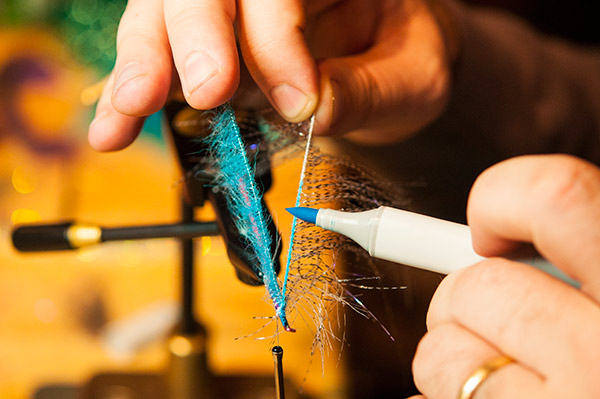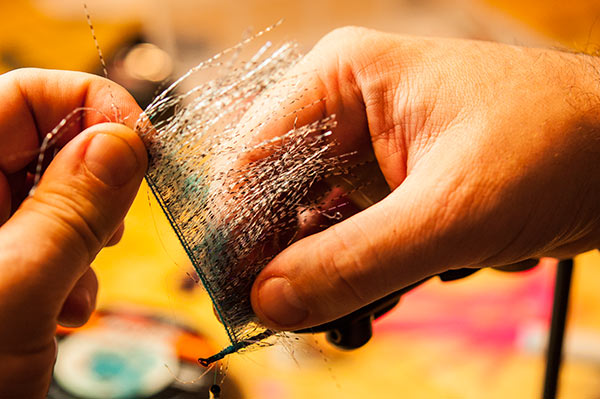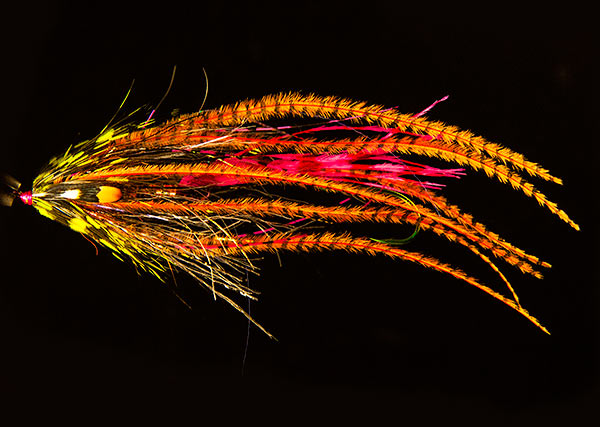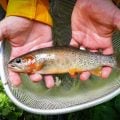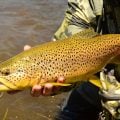Back to the Future: The Flies of Greg Senyo Part II
In last week’s installment, we looked at the ideas that inform the fly patterns of one of the sport’s most innovative designers and tiers—Steelhead Alley’s native son, Greg Senyo. This week we’ll be taking a closer look at the materials and techniques that make up Greg’s body of work by walking you through two of his signature patterns, the Predator Scandi and the Tropic Thunder.
Looking at these patterns, I kind of want to eat them—even though they don’t resemble anything that grows on earth (though I wouldn’t be surprised if a hookless version is swimming through the rivers of distant, unnamed planets). I can’t tell if it’s the profile or the proportions, the intelligence of the design or the harmony of colors, but I find myself really responding to these flies. It got me thinking back to an article I recently read where biologists discovered that many primates can recognize snakes as dangerous even if they’ve been raised in captivity and have never seen a snake before. When a steelhead sees one of Greg’s flies, I like to think that something similar happens: though it’s never seen a Predator Scandi or Tropic Thunder, it recognizes the shape, movement and color as true to the idea of life. And not scary, of course, but tasty. Very, very tasty.
As a fly tier, the thing that impresses me most about these two particular patterns is the working relationship between the synthetic and natural materials. The synthetics act not only as a stage (the various underwings) but as a spotlight (the Lateral Scale), upon and under which the natural materials—in this case Finn raccoon and ostrich herl—strut, fret and swim their hours. They are eminently castable, swimmable, and, if the steelhead of Third Coast tribs are to be trusted, eminently eatable.
 Our first creation of the day is the Predator Scandi, which features one of Senyo’s latest and most versatile materials, Predator Wrap. Since it’s inception this year it’s become a staple of Great Lakes muskie tiers and steelheaders alike. The material comes in both clear, barred and freckled configurations and, like all of Senyo’s products, is distributed by the fine folks at Hareline Dubbin Inc. “I’ve never had someone tell me they didn’t want to fish one of these flies,” Senyo says. “I’ve only heard people say they didn’t want to fish it because they didn’t want to lose it.”
Our first creation of the day is the Predator Scandi, which features one of Senyo’s latest and most versatile materials, Predator Wrap. Since it’s inception this year it’s become a staple of Great Lakes muskie tiers and steelheaders alike. The material comes in both clear, barred and freckled configurations and, like all of Senyo’s products, is distributed by the fine folks at Hareline Dubbin Inc. “I’ve never had someone tell me they didn’t want to fish one of these flies,” Senyo says. “I’ve only heard people say they didn’t want to fish it because they didn’t want to lose it.”
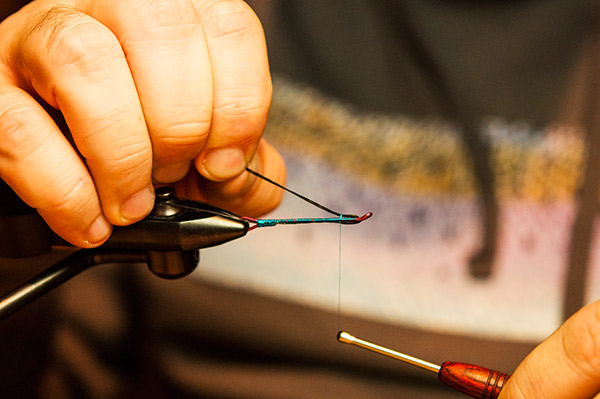 The process begins by tying in the (red) wire for the (blue) stinger hook and laying a cushy threadbase—in this case Wapsi’s Peacock Blue Ultrathread. “Building a soft threadbase, especially when you’re tying in wires and tinsels and things like that, really helps lock everything into place.” Senyo has developed a line of colored wires, hooks and shanks for the modern tier interested in making every fly-building decision “count.” As its name suggests, the Predator Scandi blends the Atlantic salmon and steelhead tying traditions within the world of synthetic materials. More specifically, it introduces some of the meticulousness and ornamentation of Atlantic Salmon tying into the realm of hard-working steelhead patterns. “I love traditional flies,” says Senyo. “A wooly bugger in the mouth of a world-record brown trout doesn’t get me going. But bringing traditional tying into today’s word–that does. It gives us a chance to not lose our history, even as traditional materials are getting either hard to come by or non-existent.”
The process begins by tying in the (red) wire for the (blue) stinger hook and laying a cushy threadbase—in this case Wapsi’s Peacock Blue Ultrathread. “Building a soft threadbase, especially when you’re tying in wires and tinsels and things like that, really helps lock everything into place.” Senyo has developed a line of colored wires, hooks and shanks for the modern tier interested in making every fly-building decision “count.” As its name suggests, the Predator Scandi blends the Atlantic salmon and steelhead tying traditions within the world of synthetic materials. More specifically, it introduces some of the meticulousness and ornamentation of Atlantic Salmon tying into the realm of hard-working steelhead patterns. “I love traditional flies,” says Senyo. “A wooly bugger in the mouth of a world-record brown trout doesn’t get me going. But bringing traditional tying into today’s word–that does. It gives us a chance to not lose our history, even as traditional materials are getting either hard to come by or non-existent.”
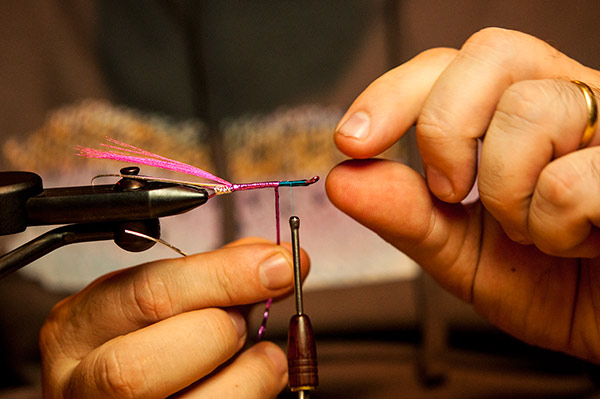 Next series of steps: tie in a tag of silver tinsel, followed by a contrasting clump of semi-supple synthetic material such as Fluoro Fiber. “This isn’t just a hotspot on a fly. It’s a foundation that’s going to help hold the wing up and prevent the materials from fouling on the hook.” Hit the base of the Fluoro Fiber with a dot of super glue, then hold the fibers at a 45 degree angle to the shank while it dries.
Next series of steps: tie in a tag of silver tinsel, followed by a contrasting clump of semi-supple synthetic material such as Fluoro Fiber. “This isn’t just a hotspot on a fly. It’s a foundation that’s going to help hold the wing up and prevent the materials from fouling on the hook.” Hit the base of the Fluoro Fiber with a dot of super glue, then hold the fibers at a 45 degree angle to the shank while it dries.
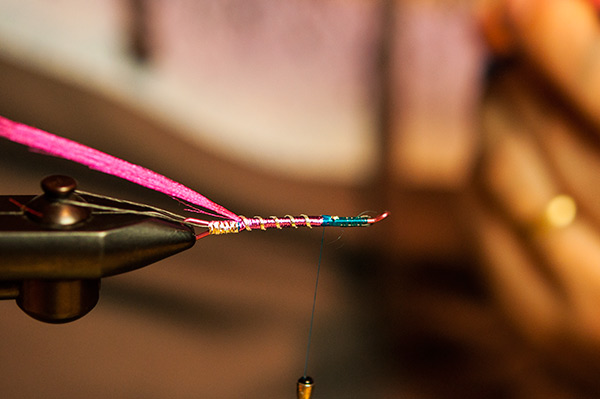 Ornamentation follows with spiral wraps of silver oval tinsel over the flat magenta tinsel body. The butt section should be about half the size of the head of the fly, which is about half the size of the midsection.
Ornamentation follows with spiral wraps of silver oval tinsel over the flat magenta tinsel body. The butt section should be about half the size of the head of the fly, which is about half the size of the midsection.
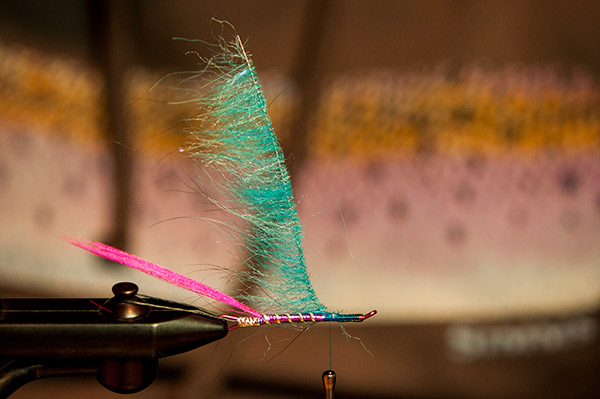 Next, tie in the first of the two synthetic scaffolding materials: the Enrico Puglisi Streamer Brush. Note that Greg has removed the fibers from one half of the brush in much the same fashion you’d remove one side of the fibers from a natural material like mallard flank or partridge flank for a sparser, more active hackle.
Next, tie in the first of the two synthetic scaffolding materials: the Enrico Puglisi Streamer Brush. Note that Greg has removed the fibers from one half of the brush in much the same fashion you’d remove one side of the fibers from a natural material like mallard flank or partridge flank for a sparser, more active hackle.
 Next, we prepare the Predator Wrap by cutting a taper into the fibers of the material. This will give the fly a more fusiform, thus natural, thus eatable shape.
Next, we prepare the Predator Wrap by cutting a taper into the fibers of the material. This will give the fly a more fusiform, thus natural, thus eatable shape.
Tie in the Predator Wrap directly in front of the EP Streamer Brush. These two will be palmered simultaneously. At this point, Greg uses a Copic dye marker to color the trim and blend the colors.
What follows is the most difficult, and arguably most important, part of this built. Controlling both sets of fibers to make sure they point backwards, use your other hand to carefully wrap the fibers forward. Be careful to make sure these materials wrap in front of, not on top of, each other.
 Finish building the rest of the head in this order: Finn Raccoon wing (as long as the natural world allows), three strands of Lateral Scale (less is more), purple guinea feather collar, jungle cock eye. Tie off and apply your preferred head cement. All that remains is the most innovative and time-saving part of this build. Enter Clear Cure Goo.
Finish building the rest of the head in this order: Finn Raccoon wing (as long as the natural world allows), three strands of Lateral Scale (less is more), purple guinea feather collar, jungle cock eye. Tie off and apply your preferred head cement. All that remains is the most innovative and time-saving part of this build. Enter Clear Cure Goo.
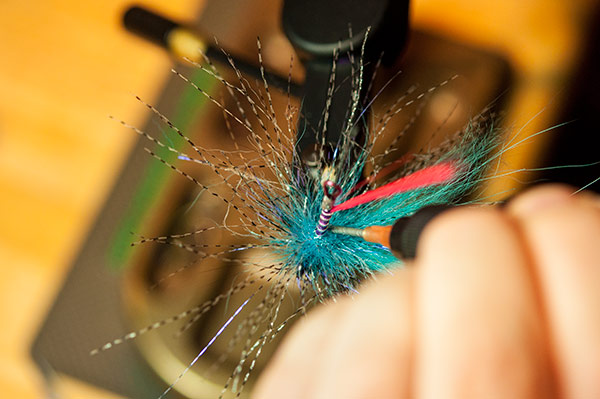 Turn the fly over in the vise and carefully work the materials out away from the shank. Apply either Thin or Tack-Free Clear Cure Goo to an area just a bit smaller than a dime. Use your bodkin or applicator to work the material in. When satisfied with your distribution, hit the glue with your UV light for 10 seconds or so to cure it. Voila—you’ve given your fly got curves that can and will not quit.
Turn the fly over in the vise and carefully work the materials out away from the shank. Apply either Thin or Tack-Free Clear Cure Goo to an area just a bit smaller than a dime. Use your bodkin or applicator to work the material in. When satisfied with your distribution, hit the glue with your UV light for 10 seconds or so to cure it. Voila—you’ve given your fly got curves that can and will not quit.
Next up, the world premier of Greg’s Tropic Thunder—or as I like to call it, Spring Break with a Stinger Hook.
Let’s get started.
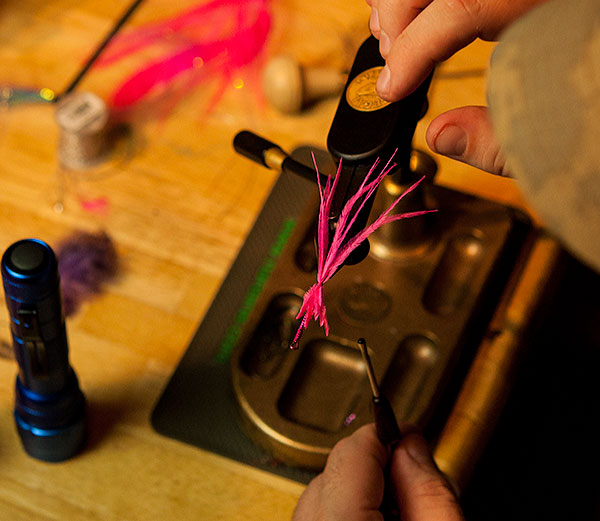 Begin by tying in a handful of ostrich plumes as a tag/underwing—the tips should extend to a point just beyond the stinger hook. As you did with the Fluoro Fiber in the first step, hit the base with a drop of super glue and allow it to dry at about a 45 degree angle from the shank. This will help prevent fouling.
Begin by tying in a handful of ostrich plumes as a tag/underwing—the tips should extend to a point just beyond the stinger hook. As you did with the Fluoro Fiber in the first step, hit the base with a drop of super glue and allow it to dry at about a 45 degree angle from the shank. This will help prevent fouling.
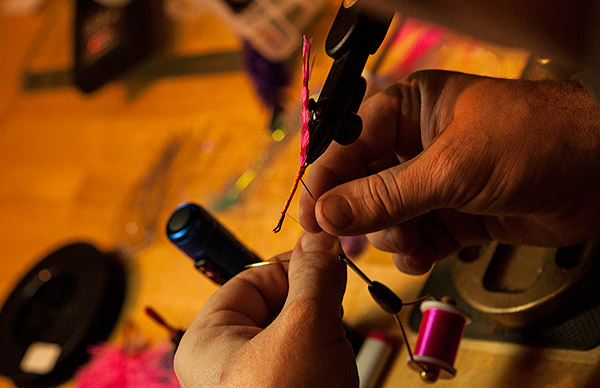 Next, build an orange floss underbody and rib it with gold tinsel. As you can see in the image above, Greg has gone in and barred the ostrich herl with a magenta-colored Copic marker.
Next, build an orange floss underbody and rib it with gold tinsel. As you can see in the image above, Greg has gone in and barred the ostrich herl with a magenta-colored Copic marker.
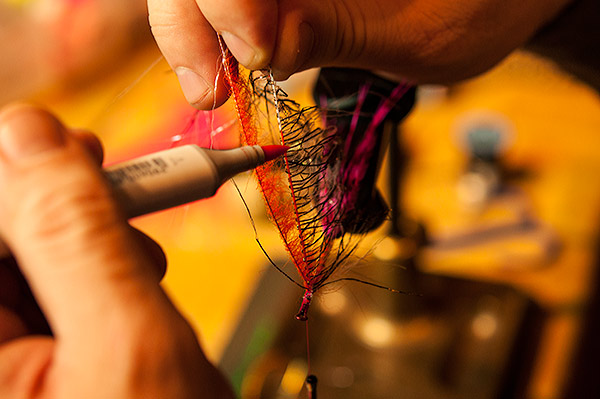 This next step should start to look familiar. Tie in a length of EP Streamer Brush, one sided trimmed, followed by a length of carefully tapered Predator Wrap. Dye the wrap in order to better blend the materials.
This next step should start to look familiar. Tie in a length of EP Streamer Brush, one sided trimmed, followed by a length of carefully tapered Predator Wrap. Dye the wrap in order to better blend the materials.
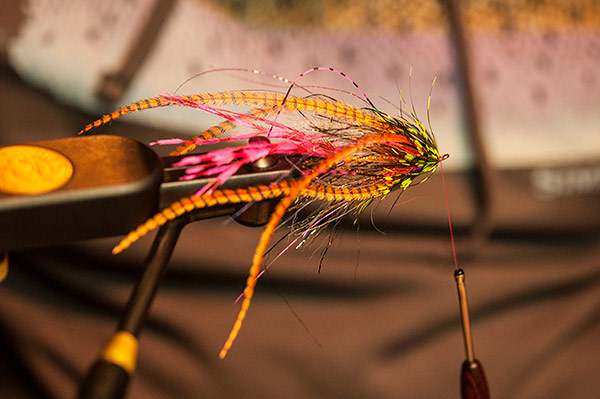 In order, tie in ten lengths of ostrich herl, followed by just as many single fibers of Lady Amherst. Three strands of Lateral Scale is par for this course, followed by a chartreuse guinea collar. Finish, if you please, with a jungle cock eye feather (Hareline makes a synthetic version if you can’t get your hands on the real stuff).
In order, tie in ten lengths of ostrich herl, followed by just as many single fibers of Lady Amherst. Three strands of Lateral Scale is par for this course, followed by a chartreuse guinea collar. Finish, if you please, with a jungle cock eye feather (Hareline makes a synthetic version if you can’t get your hands on the real stuff).
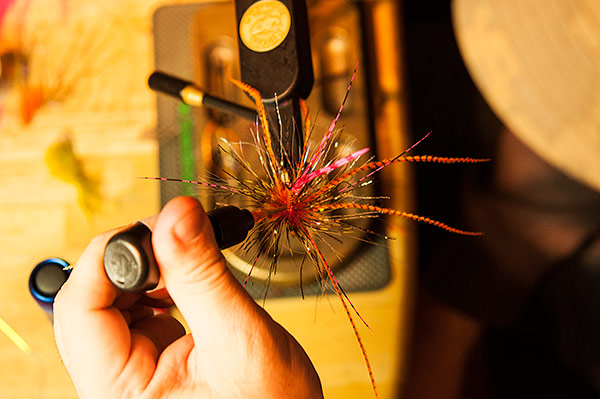 As you’ve come to expect, it’s now time to tie off and flip your fly over. Apply a dab of Thin or Tack-Free Clear Cure Goo, hit it with the UV curing light, and you’re done. (Note: this Clear Cure trick works on any previously tied Intruder-style fly in your box. I just spent an afternoon “upgrading” my entire collection)
As you’ve come to expect, it’s now time to tie off and flip your fly over. Apply a dab of Thin or Tack-Free Clear Cure Goo, hit it with the UV curing light, and you’re done. (Note: this Clear Cure trick works on any previously tied Intruder-style fly in your box. I just spent an afternoon “upgrading” my entire collection)
These two patterns are satisfying to tie, easy to cast, and swim like a starving steelhead’s technicolor dream. It’s my hope that they give you a few new ideas about how to evolve and build patterns for use on your own homewaters, be they Third Coast, West Coast or East. For many of us, chrome is the new normal from this point forward through the winter. This column is an invitation to get out there and make the most—and best—of your anadramous season.
